初中英语时态知识点:过去将来时的标志词
- 格式:docx
- 大小:11.72 KB
- 文档页数:4
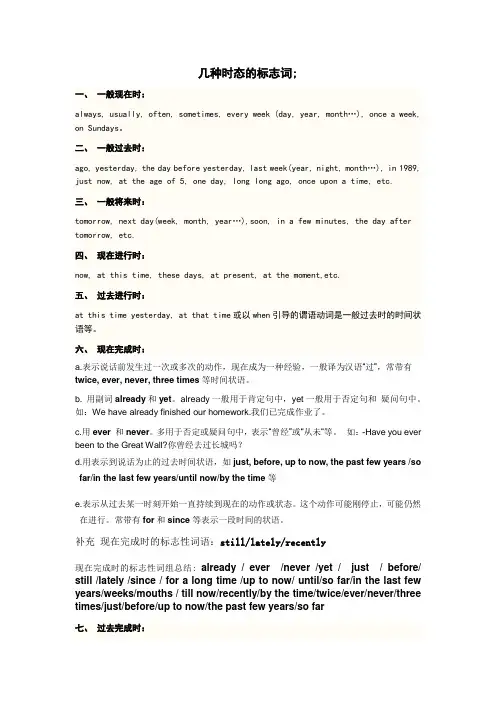
几种时态的标志词;一、一般现在时:always, usually, often, sometimes, every week (day, year, month…), once a week, on Sundays。
二、一般过去时:ago, yesterday, the day before yesterday, last week(year, night, month…), in 1989, just now, at the age of 5, one day, long long ago, once upon a time, etc.三、一般将来时:tomorrow, next day(week, month, year…),soon, in a few minutes, the day after tomorrow, etc.四、现在进行时:now, at this time, these days, at present, at the moment,etc.五、过去进行时:at this time yesterday, at that time或以when引导的谓语动词是一般过去时的时间状语等。
六、现在完成时:a.表示说话前发生过一次或多次的动作,现在成为一种经验,一般译为汉语“过”,常带有twice, ever, never, three times等时间状语。
b. 用副词already和yet。
already一般用于肯定句中,yet一般用于否定句和疑问句中。
如:We have already finished our homework.我们已完成作业了。
c.用ever和never。
多用于否定或疑问句中,表示“曾经”或“从未“等。
如:-Have you ever been to the Great Wall?你曾经去过长城吗?d.用表示到说话为止的过去时间状语,如just, before, up to now, the past few years /so far/in the last few years/until now/by the time等e.表示从过去某一时刻开始一直持续到现在的动作或状态。
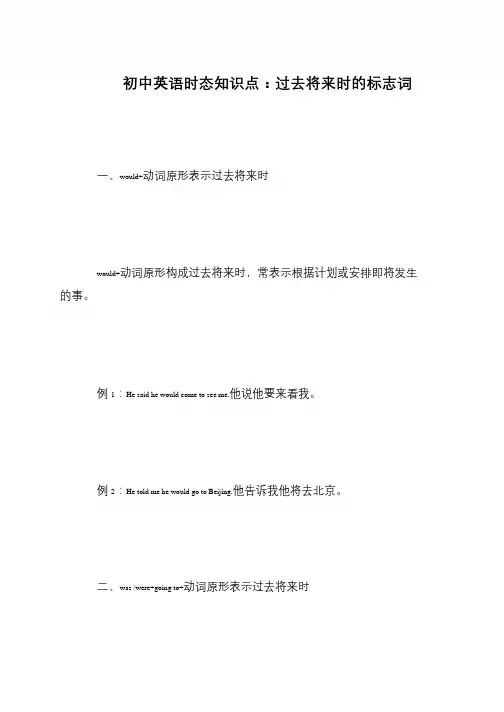
初中英语时态知识点:过去将来时的标志词一、would+动词原形表示过去将来时would+动词原形构成过去将来时,常表示根据计划或安排即将发生的事。
例1:He said he would come to see me.他说他要来看我。
例2:He told me he would go to Beijing.他告诉我他将去北京。
二、was /were+going to+动词原形表示过去将来时was /were+going to+动词原形也可表示根据计划或安排即将发生的事。
例1:She said she was going to start at once.她说她将立即出发。
例2:I was told that he was going to return home.有人告诉我他准备回家。
was /were+going to+动词原形还可表示根据当时情况判断有可能但不一定会发生某事。
例:It seemed as if it was going to rain.看来好像要下雨。
三、某些动词的过去进行时可表示过去将来时come,go,leave,arrive,start 等严格按照时间表发生的表起止的动词可用过去进行时代替过去将来时。
例1:He said the train was leaving at six the next morning.他说火车第二天早晨出发。
例2:She told me she was coming to see me.她告诉我她要来看我。
四、特定场合的一般过去时可表示过去将来时条件状语从句和时间状语从句中须用一般过去时代替过去将来时。
例1:I didn't know when she would come, but when she came Iwould let you know.我不知道她什幺时候来,但她来了我会告诉你。
析:第一个when 引导宾语从句,可使用将来时,第二个when 引导时间状语从句,只能用一般过去时代替过去将来时。
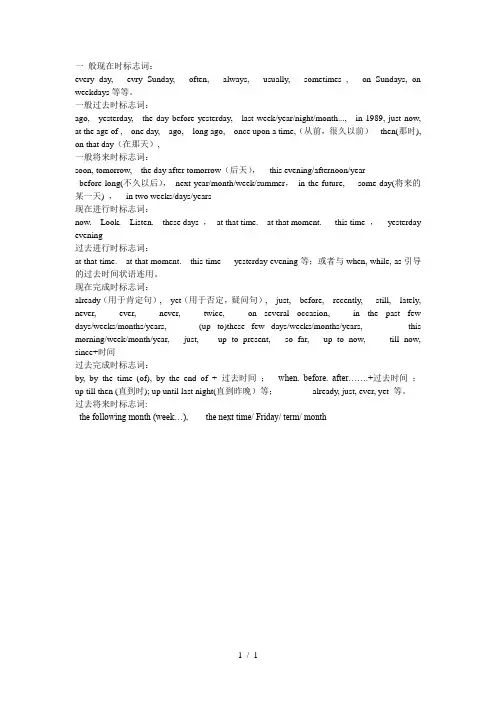
一般现在时标志词:every day, evry Sunday, often, always, usually, sometimes , on Sundays, on weekdays等等。
一般过去时标志词:ago, yesterday, the day before yesterday, last week/year/night/month..., in 1989, just now, at the age of , one day, ago, long ago, once upon a time,(从前,很久以前)then(那时), on that day(在那天),一般将来时标志词:soon, tomorrow, the day after tomorrow(后天),this evening/afternoon/yearbefore long(不久以后),next year/month/week/summer,in the future, some day(将来的某一天) ,in two weeks/days/years现在进行时标志词:now. Look. Listen. these days ,at that time. at that moment. this time ,yesterday evening过去进行时标志词:at that time. at that moment. this time yesterday evening等;或者与when, while, as引导的过去时间状语连用。
现在完成时标志词:already(用于肯定句), yet(用于否定,疑问句), just, before, recently, still, lately, never, ever, never, twice, on several occasion, in the past few days/weeks/months/years, (up to)these few days/weeks/months/years, this morning/week/month/year, just, up to present, so far, up to now, till now, since+时间过去完成时标志词:by, by the time (of), by the end of + 过去时间;when. before. after…….+过去时间;up till then (直到时); up until last night(直到昨晚)等;already, just, ever, yet 等。
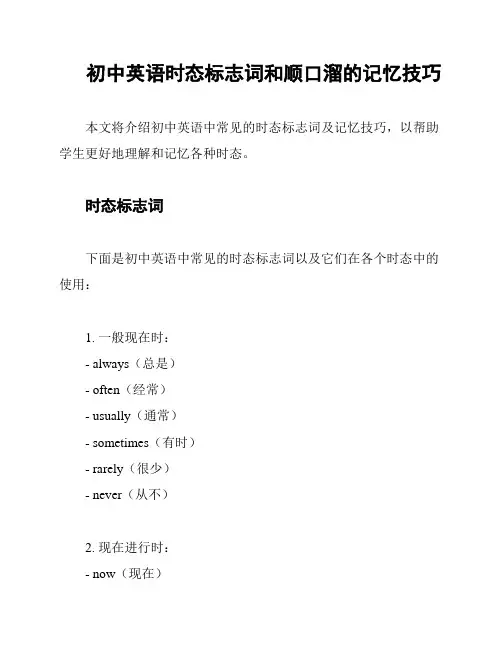
初中英语时态标志词和顺口溜的记忆技巧本文将介绍初中英语中常见的时态标志词及记忆技巧,以帮助学生更好地理解和记忆各种时态。
时态标志词下面是初中英语中常见的时态标志词以及它们在各个时态中的使用:1. 一般现在时:- always(总是)- often(经常)- usually(通常)- sometimes(有时)- rarely(很少)- never(从不)2. 现在进行时:- now(现在)- at the moment(此刻)- currently(目前)- at present(目前)- right now(立刻)3. 一般过去时:- yesterday(昨天)- last week(上周)- in 1999(在1999年)- a few minutes ago(几分钟前)- when I was a child(我小的时候)4. 过去进行时:- at that time(那个时候)- while(当...的时候)- when(当...的时候)- as(当...的时候)- during(在...期间)5. 一般将来时:- tomorrow(明天)- next week(下周)- in the future(将来)- soon(很快)- one day(有一天)6. 将来进行时:- this time tomorrow(明天这个时候)- in a week(一周后)- at this time next year(来年此时)- by the end of next month(到下个月底)记忆技巧记忆时态标志词可以使用以下顺口溜来帮助你:一般现在时要记好,总是often, 通常usually.现在进行时,此刻用,now, at the moment记心头.一般过去时记起来,昨天yesterday, 上周last week.过去进行时多用when,at that time, while来记存.一般将来时记清楚,明天tomorrow, 下周next week.将来进行时用点时刻,this time tomorrow, 一周后in a week.以上是初中英语时态标志词及顺口溜的记忆技巧,希望对你有帮助!。
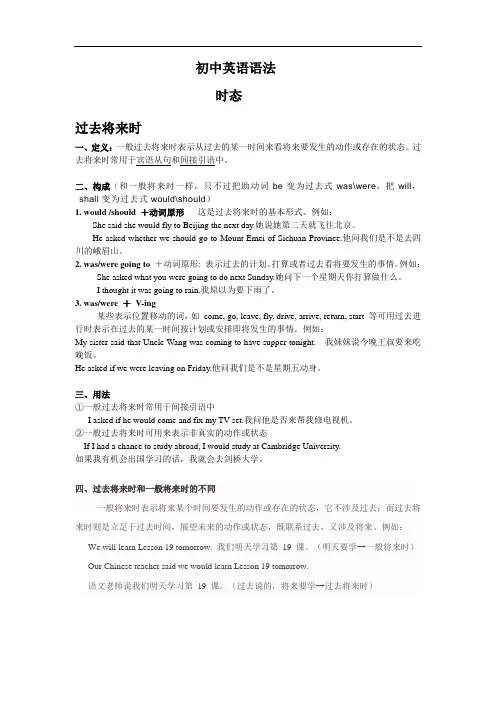
初中英语语法时态过去将来时一、定义:一般过去将来时表示从过去的某一时间来看将来要发生的动作或存在的状态。
过去将来时常用于宾语从句和间接引语中。
二、构成(和一般将来时一样,只不过把助动词be变为过去式was\were,把will,shall变为过去式would\should)1. would /should +动词原形这是过去将来时的基本形式。
例如:She said she would fly to Beijing the next day.她说她第二天就飞往北京。
He asked whether we should go to Mount Emei of Sichuan Province.他问我们是不是去四川的峨眉山。
2. was/were going to+动词原形: 表示过去的计划、打算或者过去看将要发生的事情。
例如:She asked what you were going to do next Sunday.她问下一个星期天你打算做什么。
I thought it was going to rain.我原以为要下雨了。
3. was/were +V-ing某些表示位置移动的词,如come, go, leave, fly, drive, arrive, return, start 等可用过去进行时表示在过去的某一时间按计划或安排即将发生的事情。
例如:My sister said that Uncle Wang was coming to have supper tonight. 我妹妹说今晚王叔要来吃晚饭。
He asked if we were leaving on Friday.他问我们是不是星期五动身。
三、用法①一般过去将来时常用于间接引语中I asked if he would come and fix my TV set.我问他是否来帮我修电视机。
②一般过去将来时可用来表示非真实的动作或状态If I had a chance to study abroad, I would study at Cambridge University.如果我有机会出国学习的话,我就会去剑桥大学。
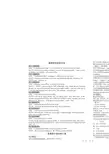
各种时态的标志词⑴、一般现在时结构:主+be(am/is/are)+其他/ 主+实义动词+其他/ 主+情态动词+动原+其他标志词:often, always, usually, sometimes , every week (day/year/month…), once a week, on Sundays, on weekdays,from time to time⑵、一般将来时结构:主+will/shall+其他/主+be going to +其他/主+be+动-ing+其他…标志词:tomorrow,in the future, next week , next Sunday,the day after tomorrow,in+ 一段时间,soon,from now on⑶、一般过去时结构:主+be(was/ were)+其他/ 主+动词过去式+其他/标志词:一段时间+ago,yesterday, in 1945,at that time,once,during the war,before,in the past , the day before yesterday, last week(year/ night/ month…), just now, at the age of 5, one day, long long ago, once upon a time,this morning,a moment ago⑷、现在完成时结构:主+have/has+动词过去分词+其他标志词:ever, never, since, already, yet, just, before, twice, once ,three times, at the moment, at present/for+时间段;since+时间点/常见的副词:lately,recently,up to now, till now,so far, these days,in the past few years(months/weeks/days)⑸、现在进行时结构:主+be(am/is/are)+动词现在分词+其他标志词:now,at the moment !at this time ,these days ,Look!Listen!⑹、过去进行时结构:主+be(was/ were)+动词现在分词+其他标志词:at that moment, at this time of yesterday, at eight last night,at 8:00am yesterday,at this time last night ,at that time⑺、过去完成时结构:主+had+动词过去分词+其他标志词:by the end of last year(term, month…),过去完成时常用在told,said,knew,heard等词后的宾语从句或间接引语中,这时从句中的动作发生在主句表示的过去的动作之前。
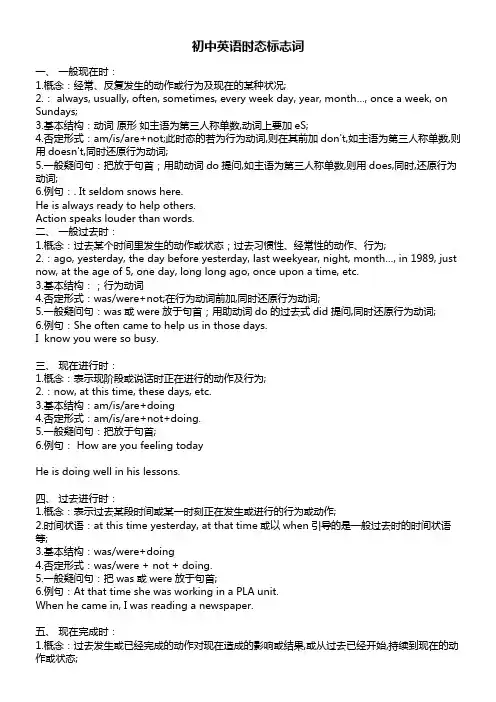
初中英语时态标志词一、一般现在时:1.概念:经常、反复发生的动作或行为及现在的某种状况;2.: always, usually, often, sometimes, every week day, year, month…, once a week, on Sundays;3.基本结构:动词原形如主语为第三人称单数,动词上要加eS;4.否定形式:am/is/are+not;此时态的若为行为动词,则在其前加don't,如主语为第三人称单数,则用doesn't,同时还原行为动词;5.一般疑问句:把放于句首;用助动词do提问,如主语为第三人称单数,则用does,同时,还原行为动词;6.例句:. It seldom snows here.He is always ready to help others.Action speaks louder than words.二、一般过去时:1.概念:过去某个时间里发生的动作或状态;过去习惯性、经常性的动作、行为;2.:ago, yesterday, the day before yesterday, last weekyear, night, month…, in 1989, just now, at the age of 5, one day, long long ago, once upon a time, etc.3.基本结构:;行为动词4.否定形式:was/were+not;在行为动词前加,同时还原行为动词;5.一般疑问句:was或were放于句首;用助动词do的过去式did 提问,同时还原行为动词;6.例句:She often came to help us in those days.I know you were so busy.三、现在进行时:1.概念:表示现阶段或说话时正在进行的动作及行为;2.:now, at this time, these days, etc.3.基本结构:am/is/are+doing4.否定形式:am/is/are+not+doing.5.一般疑问句:把放于句首;6.例句: How are you feeling todayHe is doing well in his lessons.四、过去进行时:1.概念:表示过去某段时间或某一时刻正在发生或进行的行为或动作;2.时间状语:at this time yesterday, at that time或以when引导的是一般过去时的时间状语等;3.基本结构:was/were+doing4.否定形式:was/were + not + doing.5.一般疑问句:把was或were放于句首;6.例句:At that time she was working in a PLA unit.When he came in, I was reading a newspaper.五、现在完成时:1.概念:过去发生或已经完成的动作对现在造成的影响或结果,或从过去已经开始,持续到现在的动作或状态;2.时间状语:recently, lately, since…for…,in the past few years, etc.作者: 11:19 回复此发言--------------------------------------------------------------------------------2 英语中的八种基本时态3.基本结构:have/has + done4.否定形式:have/has + not +d one.5.一般疑问句:have或has;6.例句: written an article.It has been raining these days.六、过去完成时:1.概念:以过去某个时间为标准,在此以前发生的动作或行为,或在过去某动作之前完成的行为,即“过去的过去”;2.时间状语:before, by the end of last yearterm, month…,etc.3.基本结构:had + done.4.否定形式:had + not + done.5.一般疑问句:had放于句首;6.例句:As soon as we got to the station, the train had left.By the end of last month, We had reviewed four books七、一般将来时:1.概念:表示将要发生的动作或存在的状态及打算、计划或准备做某事;2.时间状语:tomorrow, next dayweek, month, year…,soon, in a few minutes, by…,the day after tomorrow, etc.3.基本结构:am/is/are/going to + do;will/shall + do.4.否定形式:was/were + not; 在行为动词前加,同时还原行为动词;5.一般疑问句:be放于句首;will/shall提到句首;6.例句:They are going to have a competition with us in studies.It is going to rain.八、过去将来时:1.概念:立足于过去某一时刻,从过去看将来,常用于宾语从句中;2.时间状语:the next daymorning, year…,the following monthweek…,etc.3.基本结构:was/were/going to + do;would/should + do.4.否定形式:was/were/not + going to + do; would/should + not + do.5.一般疑问句:was或were放于句首;would/should 提到句首;6.例句:He said he would go to Beijing the next day.I asked who was going there。
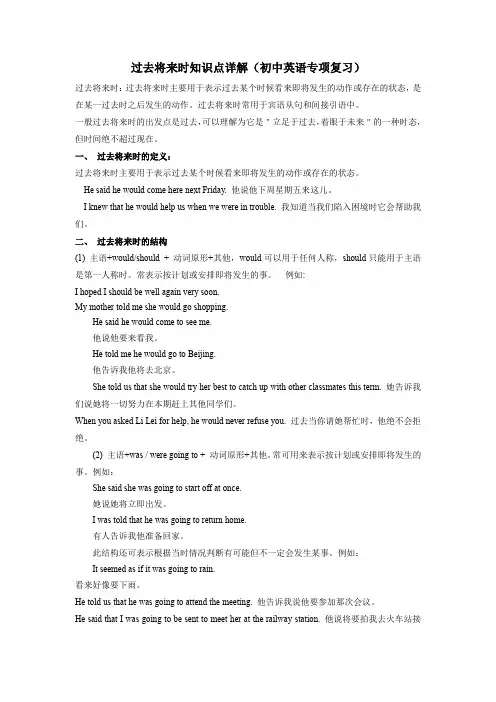
过去将来时知识点详解(初中英语专项复习)过去将来时:过去将来时主要用于表示过去某个时候看来即将发生的动作或存在的状态,是在某一过去时之后发生的动作。
过去将来时常用于宾语从句和间接引语中。
一般过去将来时的出发点是过去,可以理解为它是"立足于过去,着眼于未来"的一种时态,但时间绝不超过现在。
一、过去将来时的定义:过去将来时主要用于表示过去某个时候看来即将发生的动作或存在的状态。
He said he would come here next Friday. 他说他下周星期五来这儿。
I knew that he would help us when we were in trouble. 我知道当我们陷入困境时它会帮助我们。
二、过去将来时的结构(1) 主语+would/should + 动词原形+其他,would可以用于任何人称,should只能用于主语是第一人称时。
常表示按计划或安排即将发生的事。
例如:I hoped I should be well again very soon.My mother told me she would go shopping.He said he would come to see me.他说他要来看我。
He told me he would go to Beijing.他告诉我他将去北京。
She told us that she would try her best to catch up with other classmates this term. 她告诉我们说她将一切努力在本期赶上其他同学们。
When you asked Li Lei for help, he would never refuse you. 过去当你请她帮忙时,他绝不会拒绝。
(2) 主语+was / were going to + 动词原形+其他。
常可用来表示按计划或安排即将发生的事。
例如:She said she was going to start off at once.她说她将立即出发。
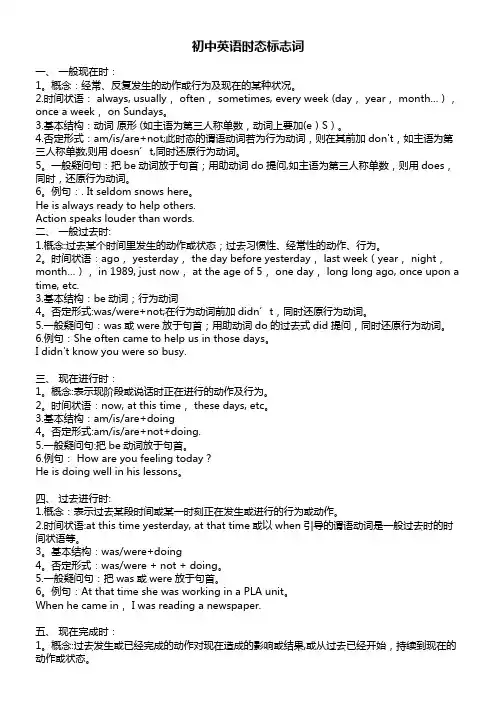
初中英语时态标志词一、一般现在时:1。
概念:经常、反复发生的动作或行为及现在的某种状况。
2.时间状语: always, usually, often, sometimes, every week (day, year, month…),once a week, on Sundays。
3.基本结构:动词原形 (如主语为第三人称单数,动词上要加(e)S)。
4.否定形式:am/is/are+not;此时态的谓语动词若为行为动词,则在其前加don't,如主语为第三人称单数,则用doesn’t,同时还原行为动词。
5。
一般疑问句:把be动词放于句首;用助动词do提问,如主语为第三人称单数,则用does,同时,还原行为动词。
6。
例句:. It seldom snows here。
He is always ready to help others.Action speaks louder than words.二、一般过去时:1.概念:过去某个时间里发生的动作或状态;过去习惯性、经常性的动作、行为。
2。
时间状语:ago, yesterday, the day before yesterday, last week(year, night,month…), in 1989, just now, at the age of 5, one day, long long ago, once upon a time, etc.3.基本结构:be动词;行为动词4。
否定形式:was/were+not;在行为动词前加didn’t,同时还原行为动词。
5.一般疑问句:was或were放于句首;用助动词do的过去式did 提问,同时还原行为动词。
6.例句:She often came to help us in those days。
I didn't know you were so busy.三、现在进行时:1。
概念:表示现阶段或说话时正在进行的动作及行为。
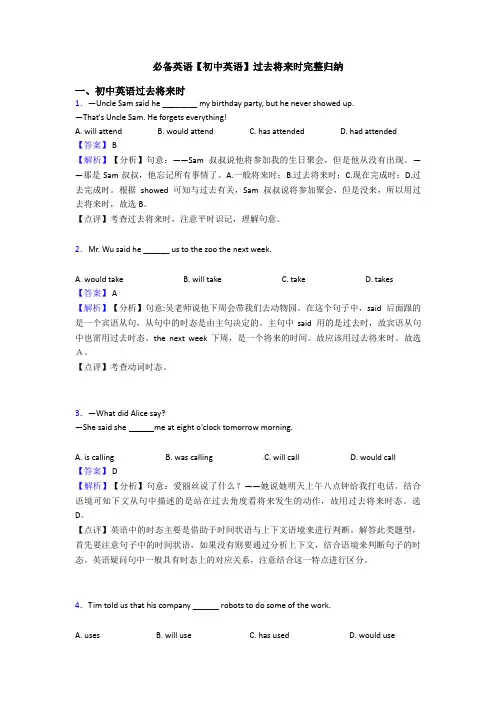
必备英语【初中英语】过去将来时完整归纳一、初中英语过去将来时1.—Uncle Sam said he ________ my birthday party, but he never showed up.—That's Uncle Sam. He forgets everything!A. will attendB. would attendC. has attendedD. had attended【答案】 B【解析】【分析】句意:——Sam叔叔说他将参加我的生日聚会,但是他从没有出现。
——那是Sam叔叔,他忘记所有事情了。
A.一般将来时;B.过去将来时;C.现在完成时;D.过去完成时。
根据showed可知与过去有关,Sam叔叔说将参加聚会,但是没来,所以用过去将来时,故选B。
【点评】考查过去将来时,注意平时识记,理解句意。
2.Mr. Wu said he ______ us to the zoo the next week.A. would takeB. will takeC. takeD. takes【答案】 A【解析】【分析】句意:吴老师说他下周会带我们去动物园。
在这个句子中,said 后面跟的是一个宾语从句,从句中的时态是由主句决定的。
主句中said 用的是过去时,故宾语从句中也需用过去时态。
the next week 下周,是一个将来的时间。
故应该用过去将来时。
故选A。
【点评】考查动词时态。
3.—What did Alice say?—She said she me at eight o'clock tomorrow morning.A. is callingB. was callingC. will callD. would call【答案】 D【解析】【分析】句意:爱丽丝说了什么?——她说她明天上午八点钟给我打电话。
结合语境可知下文从句中描述的是站在过去角度看将来发生的动作,故用过去将来时态。
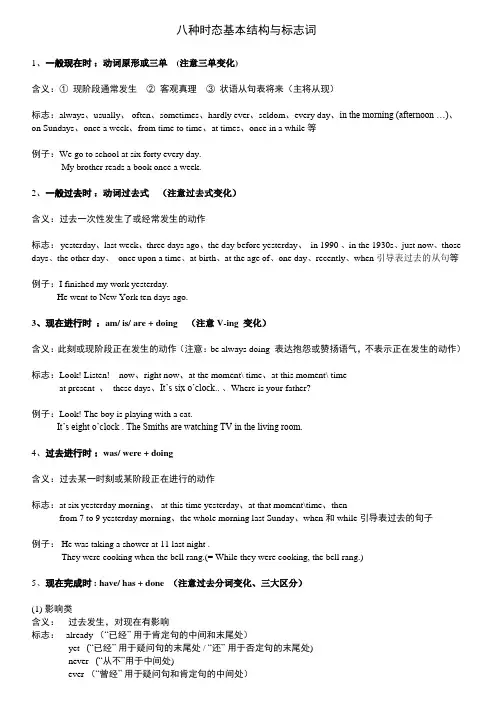
八种时态基本结构与标志词1、一般现在时:动词原形或三单(注意三单变化)含义:①现阶段通常发生②客观真理③状语从句表将来(主将从现)标志:always、usually、 often、sometimes、hardly ever、seldom、every day、in the morning (afternoon …)、on Sundays、once a week、from time to time、at times、once in a while等例子:We go to school at six forty every day.My brother reads a book once a week.2、一般过去时:动词过去式(注意过去式变化)含义:过去一次性发生了或经常发生的动作标志: yesterday、last week、three days ago、the day before yesterday、in 1990 、in the 1930s、just now、those days、the other day、once upon a time、at birth、at the age of、one day、recently、when引导表过去的从句等例子:I finished my work yesterday.He went to New York ten days ago.3、现在进行时:am/ is/ are + doing (注意V-ing 变化)含义:此刻或现阶段正在发生的动作(注意:be always doing 表达抱怨或赞扬语气,不表示正在发生的动作)标志:Look! Listen! now、right now、at the moment\ time、at this moment\ timeat present 、these days、It’s six o’clock..、Where is your father?例子:Look! The boy is playing with a cat.It’s eight o’clock . The Smiths are watching TV in the living room.4、过去进行时:was/ were + doing含义:过去某一时刻或某阶段正在进行的动作标志:at six yesterday morning、 at this time yesterday、at that moment\time、thenfrom 7 to 9 yesterday morning、the whole morning last Sunday、when和while引导表过去的句子例子: He was taking a shower at 11 last night .They were cooking when the bell rang.(= While they were cooking, the bell rang.)5、现在完成时 : have/ has + done (注意过去分词变化、三大区分)(1)影响类含义:过去发生,对现在有影响标志:already (“已经”用于肯定句的中间和末尾处)yet (“已经”用于疑问句的末尾处 / “还”用于否定句的末尾处)never (“从不”用于中间处)ever (“曾经”用于疑问句和肯定句的中间处)just (“刚刚”用于中间处)before ("之前" 用于句尾)once/ twice/ three times...例子:I have just cleaned my clothes. 我刚洗过衣服。
初中英语时态标志词一、一般现在时:1.概念:经常、反复发生的动作或行为及现在的某种状况。
2.时间状语: always, usually, often, sometimes, every week (day, year, month…), once a week, on Sundays。
3.基本结构:动词原形(如主语为第三人称单数,动词上要加(e)S)。
4.否定形式:am/is/are+not;此时态的谓语动词若为行为动词,则在其前加don't,如主语为第三人称单数,则用doesn't,同时还原行为动词。
5.一般疑问句:把be动词放于句首;用助动词do提问,如主语为第三人称单数,则用does,同时,还原行为动词。
6.例句:. It seldom snows here.He is always ready to help others.Action speaks louder than words.二、一般过去时:1.概念:过去某个时间里发生的动作或状态;过去习惯性、经常性的动作、行为。
2.时间状语:ago, yesterday, the day before yesterday, last week(year, night, month…), in 1989, just now, at the age of 5, one day, long long ago, once upon a time, etc.3.基本结构:be动词;行为动词4.否定形式:was/were+not;在行为动词前加didn't,同时还原行为动词。
5.一般疑问句:was或were放于句首;用助动词do的过去式did 提问,同时还原行为动词。
6.例句:She often came to help us in those days.I didn't know you were so busy.三、现在进行时:1.概念:表示现阶段或说话时正在进行的动作及行为。
常见时态标志词常见的时态标志词包括:1. 一般现在时:do/does(被动:is/am/are done),常用于描述现阶段经常发生的动作或存在的状态,如“We go to school at six forty every day.”“My brother reads a book once a week.”2. 现在进行时:am/is/are+doing,常用于描述正在进行的动作,如“Look! He is running now.”3. 一般将来时:will do,常用于描述将要发生的动作或存在的状态,如“I will call you tomorrow.”4. 过去进行时:was/were+doing,常用于描述过去某个时刻正在进行的动作,如“He was playing basketball at 5:00 yesterday afternoon.”5. 现在完成时:have/has+done,常用于描述已经完成的动作或存在的状态,如“I have finished my homework.”6. 过去完成时:had+done,常用于描述过去的某个时刻之前已经完成的动作,如“By the end of last year, they had built many new houses.”7. 过去将来时:would do,常用于描述过去的某个时刻预测未来的动作或状态,如“He said he would go to New York next year.”8. 过去完成进行时:had been doing,常用于描述过去的某个时刻之前一直在进行的动作,如“They had been waiting for the bus for half an hour before it arrived.”这些时态标志词可以帮助我们更好地理解和使用英语中的时态,在不同的语境中表达准确的时间关系和动作状态。
英语的八大时态包括现在时、过去时、将来时、过去将来时、现在进行时、过去进行时、将来进行时和过去将来进行时。
以下是每个时态的标志词:
1. 现在时:always, often, every day, in the morning, usually, always.
2. 过去时:yesterday, last night, the other day, a few days ago, earlier, in 1980.
3. 将来时:tomorrow, next week, in a few days, in the future, in a year.
4. 过去将来时:the day before yesterday, the other day when I was young, a few years ago.
5. 现在进行时:now, at present, at this moment.
6. 过去进行时:at that time,in those days,in the past,last night,while.
7. 将来进行时:at this time tomorrow,next week,in a few days,in the future.
8. 过去将来进行时:the day before yesterday,the other day when I was young,a few years ago.
以上内容仅供参考,建议查阅语法书籍或咨询英语老师以获取更全面和准确的信息。
初中英语知识点总结过去将来时过去将来时(Future in the Past)是指在过去一些时间或其中一段时间里,我们预测或表示将来发生的动作或情况。
在英语中,我们使用“would”或“was/were going to”来表示过去将来时。
下面是关于过去将来时的详细知识点总结。
1.过去将来时的结构a) 使用“would + 动词原形”来表示过去将来时。
例如:- She promised she would buy me a gift.(她答应会给我买一份礼物。
)b) 使用“was/were going to + 动词原形”来表示过去将来时。
例如:- They were going to visit their grandparents but it started raining.(他们本打算去看望他们的祖父母,但是天开始下雨了。
)- She was going to have dinner with her friends but she got sick.(她本来要和朋友一起吃晚饭,但是她生病了。
)2.过去将来时的用法a)表示过去一些时间或其中一段时间里的计划、打算或意愿。
例如:- She told me she would travel to Europe next summer.(她告诉我她将在明年夏天去欧洲旅行。
)- We were going to have a picnic in the park, but it rained heavily.(我们本打算在公园里野餐,但是下起了大雨。
)b)用于间接引语中,表示过去别人的意愿、请求、建议等。
例如:- He said he would help me with my homework.(他说他会帮我做作业。
)- She asked if I would like to have dinner with her.(她问我是否愿意和她一起吃晚饭。
英语时态是英语语法中的重要部分,下面是英语各时态的标志词和句型介绍:1. 现在时态:现在时态通常表示当前发生的事情,标志词有now, today, always, frequently等。
句型为:主语+动词+其他成分(如宾语、状语等)。
例如:I eat apples every day.2. 过去时态:过去时态表示过去发生的事情,标志词有yesterday, last night, once upon a time等。
句型为:主语+动词的过去式+其他成分。
例如:I played football yesterday.3. 将来时态:将来时态表示将来发生的事情,标志词有will, tomorrow, next week等。
句型为:主语+will+动词原形+其他成分。
例如:It will rain tomorrow.4. 进行时态:进行时态表示正在进行的事情,标志词有be动词和动词ing 形式。
句型为:主语+be动词+动词ing形式+其他成分。
例如:She is singing a song now.5. 完成时态:完成时态表示已经完成的事情,标志词有have, had等。
句型为:主语+have/has+动词过去分词+其他成分。
例如:I have finished my homework.6. 完成进行时态:完成进行时态表示某个动作已经完成,并且这个动作是在过去一段时间内持续进行的。
标志词有have been, had been 等。
句型为:主语+have/has been+动词的现在分词+其他成分。
例如:I have been studying English for two years.7. 过去进行时态:过去进行时态表示在过去某个时间点正在进行的事情,标志词有was, were等。
句型为:主语+was/were+动词ing形式+其他成分。
例如:I was watching TV at 8:00 yesterday evening.8. 过去完成时态:过去完成时态表示在过去某个时间点之前已经完成的事情,标志词有had, had been等。
初中英语8个时态讲解—中考必考英英英英英英英一般现在时一一一一一一一1、一一一一一一一一一一一。
She often speaks English.I leave home for school at 7 every morning.2、一一一一一一一一一一一一一一一一一一一一。
He seems to feel a bit down today.He works as a driver.3、一一一一一一一一一一一一一一一一一一一一一一。
Shanghai lies in the east of China.Columbus proved that the earth is round.Where there is a will, there is a way.一一一一一一一一一一一一一一一一一一一一一一一一一。
When Bill comes , ask him to wait for me.I shall go there tomorrow unless I’m too busy.一般过去时一一一一一一一一1、一一一一一一一一一一一一一一一一一一。
Jim rang you just now.Liu Ying was in America last year.2、一一一一一一一一一一一一一一,一一一used to do sth.一一一一一一一一一一一一一一一一一一When I was a kid, I often played football in the street.She used to visit her mother once a week.*一一一一:sb. used to do sth.一一一一一一一一一一一一一to一一一一一一一一一一一一sb. be used to sth./doing sth.一一一一一一一一/一一一一一一to一一一一一3、一一一一一一一一一一一一一一一一一一一一一一一一一一一一一一一一一一一一一一一一want, hope, wonder, think, intend一一一一一一一could, would一I wondered if you could have a word with me.I hoped you could help me with my English.Would you mind my sitting here?一般将来时一一一will / shall +一一一一1、一一一一一一一一一一一一一一一。